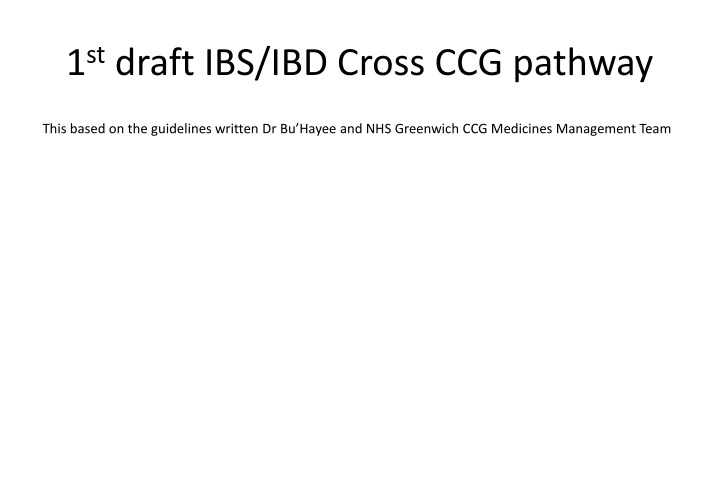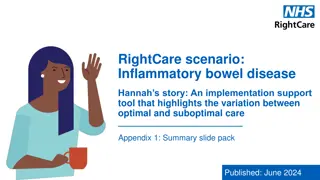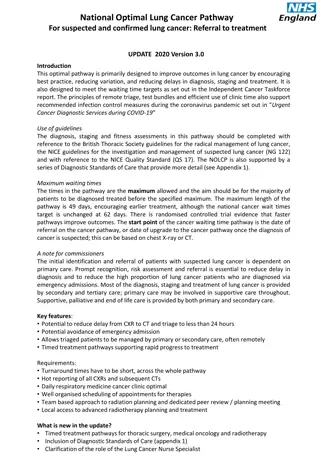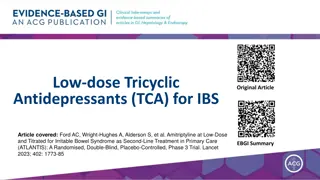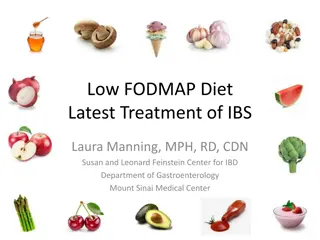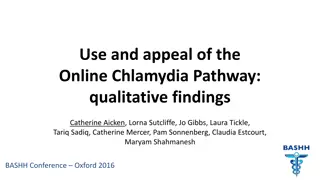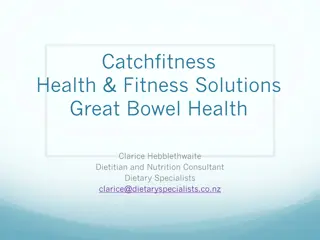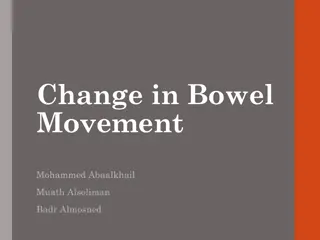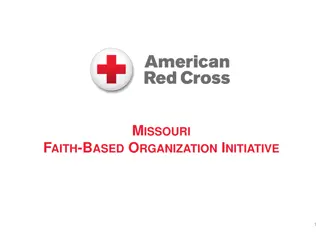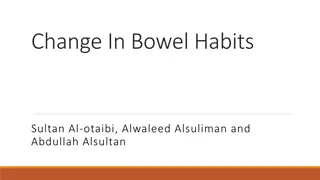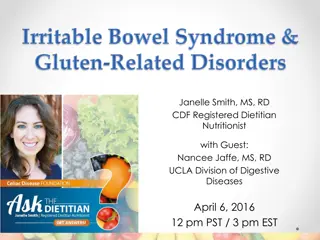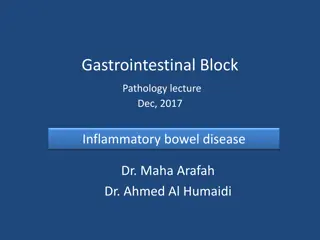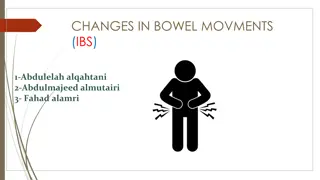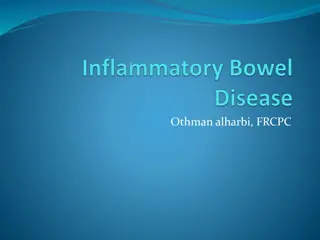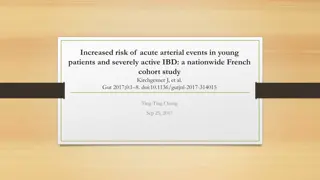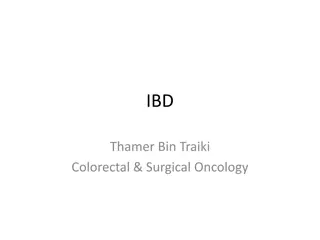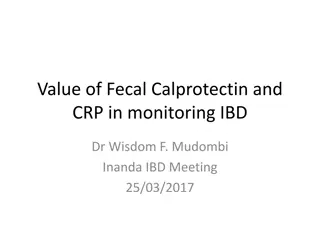IBS/IBD Cross CCG Pathway Guidelines - Initial Assessment and Treatment Options
This content outlines the pathway for managing patients presenting with symptoms suggestive of IBS or IBD, following guidelines by Dr. Bu Hayee and NHS Greenwich CCG Medicines Management Team. It covers initial assessment, investigations, red flags, referral criteria, dietary and lifestyle advice, and treatment options based on NICE recommendations. The pathway helps healthcare professionals in making informed decisions for patients with gastrointestinal disorders.
Download Presentation

Please find below an Image/Link to download the presentation.
The content on the website is provided AS IS for your information and personal use only. It may not be sold, licensed, or shared on other websites without obtaining consent from the author.If you encounter any issues during the download, it is possible that the publisher has removed the file from their server.
You are allowed to download the files provided on this website for personal or commercial use, subject to the condition that they are used lawfully. All files are the property of their respective owners.
The content on the website is provided AS IS for your information and personal use only. It may not be sold, licensed, or shared on other websites without obtaining consent from the author.
E N D
Presentation Transcript
1stdraft IBS/IBD Cross CCG pathway This based on the guidelines written Dr Bu Hayee and NHS Greenwich CCG Medicines Management Team
IBS IBS pathway 1: pathway 1: Presenting with Presenting with symptoms, but unknown IBD symptoms, but unknown IBD Suggest Advice & Guidance for:- 1. Equivocal FCALP results, these can be monitored over a longer period every 4-6w. 2. Patients with Ve FOBT rarely require further investigations 3. Patients with simple dyspepsia <55, that are non-responsive to ppI can be classified as IBS-A, FBC, ESR, Calprotectin Coeliac screen, TFTs, (stool MCS) Patient presenting with lower gastrointestinal symptoms for at least 6 months suggestive of irritable bowel syndrome (IBS) WITHOUT ALARM SYMPTOMS: Abdominal pain (relieved by defaecation, made worse by eating IBS-A) Bloating (IBS-B) Constipation (IBS-C) altered bowel frequency or stool form Diarrhoea (IBS-D) is common; overlap exists (IBS-M mixed) Bloods normal and/or FCALP 60-150 Raised CRP, ESR and/or FCALP >150 Bloods normal and/or FCALP <60 RED FLAGS Unintentional weight loss New IDA Persistent rectal bleeding/bloody diarrhoea that does no resolve. A family history of bowel or ovarian cancer > 60 years of age, a change in bowel habit lasting more than 6 weeks with looser and/more frequent stools +Ve Coeliac Screen Repeat FCALP in 4 weeks from first test; Consider IBS advice in meantime (with proviso of re-test) IBS pathway IBS pathway Primary care Primary care Increasing concern, struggling with symptoms suggest refer on. Secondary care Secondary care Consider C+B Consider C+B referral, avoid referral, avoid advising dietary advising dietary restrictions restrictions Consider Consider 2WW/Urgent 2WW/Urgent Referral to GI/ Referral to GI/Colo rectal rectal Refer for new IBD OPA Refer for new IBD OPA via via fax/hotline (to be fax/hotline (to be seen <2 seen <2- -6/52 Colo- - 6/52) )
IBS IBS pathway pathway 2: Treatment options Treatment options 2: Key This only applies to patients that IBD or other significant pathology has been excluded via IBS initial algorithm Constipation predominant symptoms symptom Trail Ispaghula and Macrogol for 3/12 each All treatment options are based on recommendations of NICE CG61 IBS 2015. Bloating, pain, diarrhoea Encourage a frequent bowel habit, as this will help decrease symptoms Offer verbal and written lifestyle and physical activity advice, see next page. Mebeverine 135mg tablets 1-2 three times a day Loperamide 2mg capsules 2-4 caps twice a day max 16 mg daily Primary care Primary care Community dietics referral for FODMAPS If pain and IBS If pain and IBS- -C consider guanylate guanylate cyclase cyclase- -C receptor agonist agonist Linaclotide Linaclotide 290 micrograms 290 micrograms once daily for once daily for 6 weeks, can be 6 weeks, can be initiated be Primary and initiated be Primary and Secondary Secondary C consider C receptor Secondary care Secondary care Referral to Gastroenterology for second line treatments Pain/Diarrhoea based Constipation/Bloating Amitriptyline 10mg Amitriptyline 10mg- -30mg at night at night 30mg Nortriptyline Nortriptyline 2.5mg 10mg at night 10mg at night 2.5mg- - Citalopram 10mg to Citalopram 10mg to 20mg once daily 20mg once daily Fluoxetine 20mg once Fluoxetine 20mg once daily daily
Dietary/Lifestyle Sheet Have regular meals and take time to eat. Avoid missing meals or leaving long gaps between eating. Drink at least eight cups of fluid per day, especially water or other non-caffeinated drinks, for example herbal teas. Restrict tea and coffee to three cups per day. Reduce intake of alcohol and fizzy drinks. It may be helpful to limit intake of high-fibre food (such as wholemeal or high-fibre flour and breads, cereals high in bran, and whole grains such as brown rice); REDUCE INSOLUBLE FIBRE. Reduce intake of 'resistant starch' (starch that resists digestion in the small intestine and reaches the colon intact), which is often found in processed or re-cooked foods. Limit fresh fruit to three portions per day (a portion should be approximately 80 g). People with diarrhoea should avoid sorbitol, an artificial sweetener found in sugar-free sweets (including chewing gum) and drinks, and in some diabetic and slimming products. People with wind and bloating may find it helpful to eat oats (such as oat-based breakfast cereal or porridge) and linseeds (up to one tablespoon per day); INCREASE SOLUBLE FIBRE. Some people find taking probiotics regularly helps relieve the symptoms of IBS. However, there is no scientific evidence to prove that probiotics work and have beneficial health effects. If you decide to try probiotics, make sure you follow the manufacturer's instructions and recommendations regarding dosage, you should continue for at least 4 weeks to notice any difference. This is not available on prescription. Some people claim therapies such as acupuncture and reflexology can help people with IBS.
Coeliac Coeliac Pathway: Pathway: Not anaemic, raised LFTs, +VE TTG +Ve Coeliac Screen, but not diagnosed Isolated GGT reassure no further action High GGT, ALT Patient declines Patient declines Organize US Offer direct access OGD Fatty Liver Organise C+B appt approx 4/52 post OGD date Check AST, plts, alb. Calculate NAAFLD Score at http://www.nafldscore.co m Repeat LFTs every 24/12 Stable in community, advise regular vaccinations, good compliance with GFD Primary care Primary care Score over - 1.45 Maximise cardiovascular risk/diabetes lifestyle factors See in clinic organise, explain diagnosis, organise DEXA and dietics RV Secondary care Secondary care Organize C+B appt Suggest Urgent to routine referral dependant on US findings Dietics; Stable weight and dexa over 18/12
IBD pathway 1: ULCERATIVE COLITIS Mesalazine (5asa) pathway Patient with known UC with flare of symptoms Taking mesalazine only Newly diagnosed patient CHECK / ENCOURAGE ADHERENCE - Typically 55% are adherent - Patients with Colonic Crohn s disease may be treated on this pathway. http://www.nice.org.uk/guidance/cg76/chapter/key-principles MAY NEED DISEASE-MODIFYING THERAPY EG. AZATHIOPRINE NO YES Severity of this flare? 2 flares in last 6/12? Consider minimising tablet burden with high strength formulations if not already MODERATE MILD SEVERE BO 4-6x per day with blood No systemic symptoms BO 1-3x per day +/- blood No systemic symptoms BO >6 per day with blood Fever, tachycardia, hypotension On zero or maintenance dose (2.4g Mesalamine, 1.5g Salofalk, 2g Pentasa) CONTACT SECONDARY CARE AT ANY STAGE IN THIS PATHWAY On rectal 5asa therapy alone (enema or supps) Primary or secondary care On maximum dose (4.8g Mesalmaine, 3g Salofalk, 4g Pentasa) Increase to maximum dose 5asa; Consider adding rectal therapy Add oral 5asa at maximum dose and strength 2/52 review if Rx changed. Symptoms controlled? YES Prescribe prednisolone 40mg OD reducing by 5mg per week to zero with Ca+vitD suppl OD Continue maximal therapy for 4/52 then reduce to maintenance unless evidence of disease activity NO Call Gastro SpR on-call Admit via Medical team Seen by IBD Cons within 48h Advice from IBD helpine and/or refer for urgent OPA via helpline(<2/52) Secondary care
IBD pathway 2: IMMUNOSUPPRESSANT progression to BIOLOGIC THERAPY Start point 1 Start point 2 Patient requiring therapy despite pathway 2 INFLIXIMAB Rescue, initial funding request for 12/12 Hospitalised patient VACCINATION AND VIRAL SCREEN Should be performed at this stage Start AZA Acute severe UC YES based on TPMT result In-hospital response? High risk IBD? Steroid dependency NO NO ?Surgery INITIAL AZA MONITORING Fortnightly FBC for 3/12, then every 3/12 there after AZA monotherapy Biologic Pathway (#3) YES TGN level at least at 12/52 Recheck if failing therapy NO YES NO Response at 12 weeks? CI to biologic? Alternative immunomodulator? TACROLIMUS/MTX YES Remission for biologic cessation is defined as asymptomatic and biochemical and/or endoscopic and/or radiologic evidence of healing YES NO Response at 12 weeks? Virtual / High risk or Complex IBD Young patients (<40 years); Fulminant disease Previous surgery for Crohn s disease / early recurrence Fistulising/penetrating Crohn s disease at presentation Unable to use steroids as bridge to immunosuppression Already on immunosuppression (and adequate dosing) telephone/ nurse- led F2F follow-up Shared care can only start after 4/12 and only if patient stable Secondary care Offer of shared care Primary care
IBD pathway 3: BIOLOGIC THERAPY, links for pathway IBD 2 The most appropriate and cost-effective anti-TNF will be selected according to NICE guidance for CD Expect 20% of local population of CD in this arm The proportion of patients will be higher in tertiary care (population outside LSLBGB) UC CD aTNF Anti -integrin 2nd line only 60% These figures are for new starters only. 40% OPD should offered subcut anti-TNF or Vedo as first line, Hospitalized IV aTNFs. INFLIXIMAB VEDOLIZUMAB ADALIMUMAB Switching of stable patients is clinically inappropriate Response at 12-16 weeks? Dose optimisation or drug-switching must be discussed in IBD MDM Reassessment may be at 4-8 weeks after change, dependent on dosing frequency This cyclical section of the pathway can be repeated TWICE. Remission for acute severe UC defined by Mayo <2 when steroid-free YES Remission for biologic cessation is defined as asymptomatic and biochemical and/or endoscopic and/or radiologic evidence of healing NO Possible to dose-optimise based on drug/Ab level? YES NO ?Surgery Switch biologic, and consider combination NO Suitable for clinical trial? On AZA? Need to optimize NO Consider stopping biologic therapy NO YES Remission at 12 months? Possible to dose-optimise based on drug/Ab level? Secondary care
